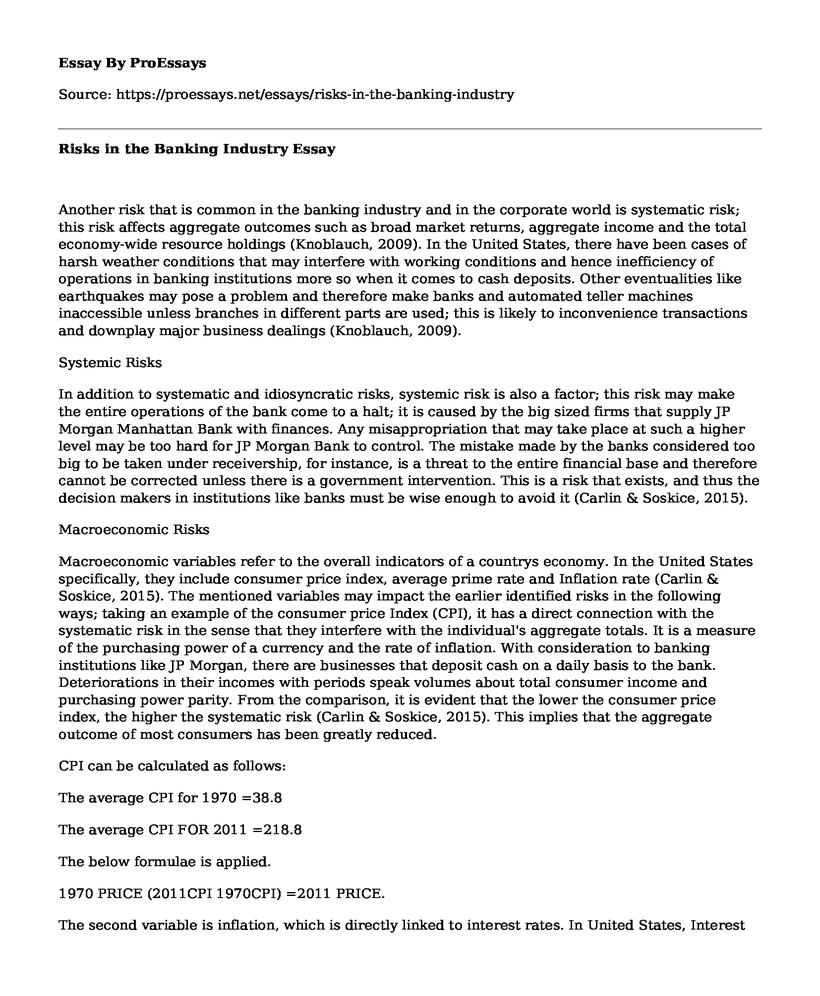Another risk that is common in the banking industry and in the corporate world is systematic risk; this risk affects aggregate outcomes such as broad market returns, aggregate income and the total economy-wide resource holdings (Knoblauch, 2009). In the United States, there have been cases of harsh weather conditions that may interfere with working conditions and hence inefficiency of operations in banking institutions more so when it comes to cash deposits. Other eventualities like earthquakes may pose a problem and therefore make banks and automated teller machines inaccessible unless branches in different parts are used; this is likely to inconvenience transactions and downplay major business dealings (Knoblauch, 2009).
Systemic Risks
In addition to systematic and idiosyncratic risks, systemic risk is also a factor; this risk may make the entire operations of the bank come to a halt; it is caused by the big sized firms that supply JP Morgan Manhattan Bank with finances. Any misappropriation that may take place at such a higher level may be too hard for JP Morgan Bank to control. The mistake made by the banks considered too big to be taken under receivership, for instance, is a threat to the entire financial base and therefore cannot be corrected unless there is a government intervention. This is a risk that exists, and thus the decision makers in institutions like banks must be wise enough to avoid it (Carlin & Soskice, 2015).
Macroeconomic Risks
Macroeconomic variables refer to the overall indicators of a countrys economy. In the United States specifically, they include consumer price index, average prime rate and Inflation rate (Carlin & Soskice, 2015). The mentioned variables may impact the earlier identified risks in the following ways; taking an example of the consumer price Index (CPI), it has a direct connection with the systematic risk in the sense that they interfere with the individual's aggregate totals. It is a measure of the purchasing power of a currency and the rate of inflation. With consideration to banking institutions like JP Morgan, there are businesses that deposit cash on a daily basis to the bank. Deteriorations in their incomes with periods speak volumes about total consumer income and purchasing power parity. From the comparison, it is evident that the lower the consumer price index, the higher the systematic risk (Carlin & Soskice, 2015). This implies that the aggregate outcome of most consumers has been greatly reduced.
CPI can be calculated as follows:
The average CPI for 1970 =38.8
The average CPI FOR 2011 =218.8
The below formulae is applied.
1970 PRICE (2011CPI 1970CPI) =2011 PRICE.
The second variable is inflation, which is directly linked to interest rates. In United States, Interest rates are determined by the Federal Reserve. This may favor or disfavor banks in case of an occurrence (Knoblauch, 2009). An occurrence of a systemic risk may result to a sudden inflation and economic meltdown. In comparison, the higher the inflation, the higher the chances of collapsing of the financial system hence systemic inflation.
Finally, is the prime rate that refers to the interest rate charged by the commercial banks like JP Morgan. It is worth noting that the higher the interest rate, the higher the chances of systematic risk (Plunkett, Allen & Attner, 2015).
Graphical representation of the relationship between interest rates and amount of loanable funds by banks
Summary
Risks are an inevitable part of business and without risks no meaningful progress can be made. The essence of being good at business is strike a balance between risks, growth, and sustainability; business owners should not risk everything they have got on a single venture or contract. As long as risks are spread, shared, or avoided altogether; all is well in business. For a business such as JP Morgan, consideration of risks and the macroeconomic variables at play is what has kept the establishment afloat for all the years it has been in operation.
References
Carlin, W. & Soskice, D. (2015). Macroeconomics. Oxford: Oxford University Press.
Gup, B. E. (2011). Banking and financial institutions: A guide for directors, investors, and counterparties. Hoboken, N.J: Wiley.
Knoblauch, A. (2009). Forecasting business cycles using macroeconomic variables. St. Gallen.
Plunkett, W., Allen, G., & Attner, R. (2015). Management: Meeting and Exceeding Customer Expectations (10th Ed.). Australia: Cengage Learning.
Cite this page
Risks in the Banking Industry. (2021, Mar 22). Retrieved from https://proessays.net/essays/risks-in-the-banking-industry
If you are the original author of this essay and no longer wish to have it published on the ProEssays website, please click below to request its removal:
- Business Paper Example on Strategic Plan Development
- Introduction to Ethics in Decision Making
- The Technology Employed by Tres Latin Foods Companies Paper Example
- Factors Determining and Influencing Organizational Structures Analysis
- Essay Sample on Employee Compensation and Benefits: Impacting Lives Beyond Payment and Mentoring
- Essay Sample on Ancient Greek Leadership: Harmonizers, Teachers, & Providers of Resources
- First Lady Leadership: Rosalyn Carter & Betty - Views & Scrutiny - Essay Sample







